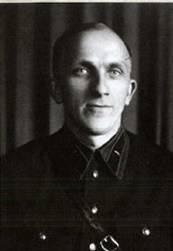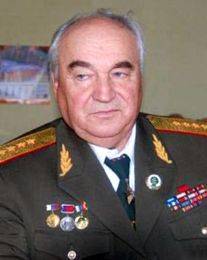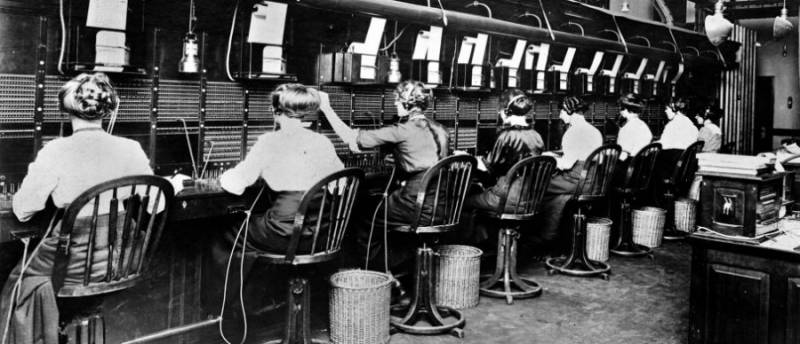Guarding the most important secrets. Government Communications Day
The need to create a system of operational management of the state, its institutions and armed forces, the Soviet government realized almost immediately after the end of the Civil War. However, the solution of this task required a serious technical modernization of the means of communication available to the Soviet state. Already in 1921, the engineers of the radio laboratory of the Moscow Electrosvyaz plant began experiments on the organization of multi-channel telephony, which ended in success - three telephone conversations were simultaneously transmitted via a cable line.
Two years later, in 1923, P.V. Shmakov successfully conducted experiments on the simultaneous transfer of telephone conversations at high and low frequencies over a cable line of length 10 kilometers. In 1925, the first high-frequency telephony equipment for copper circuits was developed, developed by a team of the Leningrad Scientific Testing Station under the guidance of P.A. Azbukina. By this time, the principle of high-frequency telephony was considered the most secure during telephone conversations. In the end, it was high-frequency telephony that was approved by the leadership of the Communist Party and the Soviet state as the basis of the government system of a Soviet country.
Since management by telephone communication was of strategic importance for the Soviet state, the general organization of the multi-channel telephone communication system immediately took over United State Political Administration (OGPU), which at that time was responsible for the country's state security. It was the strategic importance of the government communication system that explained its inclusion in the system not of the USSR Commissariat of Communications, but of the state security organs of the Soviet state.
At the end of 1920's government communication was subordinated to the 4 th branch of the Operations Division of the OGPU USSR. Considering the increased importance of the government communication system, the engineering and technical personnel that provided it were recruited on the basis of two main criteria - the highest professional competence and complete loyalty of the Soviet government. That is, the selection criteria were the same as in the recruitment of other departments and departments of the state security bodies of the USSR.
The first lines of high-frequency communication were carried out between Moscow and Leningrad and Moscow and Kharkov. Long-distance communication was provided by the highest party-state leadership of the country. 1 June 1931 of the OGPU was allocated 5-e branch of the Operations Division of the OGPU. He was headed by the personnel officer of the OGPU - NKVD Ivan Y. Lorens (1892-1937), who led the department for almost six years. When the OGPU was incorporated into the NKVD, the 5 branch of the Operations Division of the Main Directorate of State Security of the NKVD of the USSR remained the government communications management body.
The tasks of providing the country with government communications demanded reinforced and accelerated construction of medium-haul long-haul permanent aerial lines that had developed since the beginning of the 1930-s. Each line allocated two chains to the competence of state security agencies, which equipped the intermediate and terminal stations of government communications. During the 1931-1932. government communication was established between Moscow and Leningrad, Kharkov, Minsk, Smolensk. In 1933, the government communication lines connected Moscow with Gorky and Rostov-on-Don, in the 1934 year - with Kiev, during the 1935-1936 years. communications were established with Yaroslavl, Tbilisi, Baku, Sochi, Sevastopol, Voronezh, Kamyshin and Krasnodar, and in 1938 25 immediately launched new high-frequency stations, including stations in such large and strategically important cities as Arkhangelsk, Murmansk , Stalingrad, Sverdlovsk. In 1939, 11 high-frequency stations were also commissioned in Novosibirsk, Tashkent, Chita and a number of other cities. At the same time in Lyubertsy, a remote line-hardware hall of the Moscow high-frequency station was built. By 1940, 82 government communication stations operated in the country, which served 325 subscribers throughout the Soviet Union. The Moscow-Khabarovsk line, built in the 1939 year and having a length of 8615 kilometers, has become the world's longest aerial communication line in the world.
Thus, by the end of 1930, the organization of the government communication system in the Soviet Union was largely complete. High-frequency communications were used to provide contacts of the country's top leadership with the leaders of the republics, regions and territories of the Soviet Union, the administration of the most important industrial enterprises and other economic facilities, the military command and the leadership of the security forces.
In 1930-s, Soviet engineers developed the basic methods for automatically classifying telephone conversations. Thus, in 1937, the Krasnaya Zarya plant launched the production of EC-2 classifying equipment, developed by K.P. Egorov and G.V. Staritsyn. Then more developed and sophisticated MEC-2M and MEC-2A, PJ-8, UIS-3 devices were released. As a result, by the end of 1930's. With the help of EC-2 and MEC-2 inverters, it was possible to classify all the main channels of the Soviet government communications.
 After the arrest of I.Yu. Lawrence's special communications department of the NKVD USSR GUGB was headed by Ivan Yakovlevich Vorobiev (pictured), who previously worked at the Krasnaya Zarya telephone factory, and then in 1931 he was employed by the state security agencies and first held the positions of Chief Mechanic of the ATC NKVD, then the head of the liaison office of the Administrative Department of the NKVD, and then later headed the department of government liaison. In 1939, Vorobiev was replaced by the captain of state security, Mikhail Ilyinsky, as the head of the government communications department. He was one of the developers of the MA-3 and UIS-3 hardware. Ivan Vorobiev and Mikhail Ilinsky were the people under whose leadership the formation and development of the national government communications was carried out, and new stations were commissioned. After the death of Il'insky, the government communications department of the NKVD of the USSR in 1941 was again headed by Ivan Vorobyev.
After the arrest of I.Yu. Lawrence's special communications department of the NKVD USSR GUGB was headed by Ivan Yakovlevich Vorobiev (pictured), who previously worked at the Krasnaya Zarya telephone factory, and then in 1931 he was employed by the state security agencies and first held the positions of Chief Mechanic of the ATC NKVD, then the head of the liaison office of the Administrative Department of the NKVD, and then later headed the department of government liaison. In 1939, Vorobiev was replaced by the captain of state security, Mikhail Ilyinsky, as the head of the government communications department. He was one of the developers of the MA-3 and UIS-3 hardware. Ivan Vorobiev and Mikhail Ilinsky were the people under whose leadership the formation and development of the national government communications was carried out, and new stations were commissioned. After the death of Il'insky, the government communications department of the NKVD of the USSR in 1941 was again headed by Ivan Vorobyev. It should be noted that in the second half of the 1930-x - the beginning of the 1940-x. there were four structures involved in the organization and management of government communications. First, it was the aforementioned government communications department in the General Directorate of State Security of the NKVD of the USSR. Secondly, it was created on the basis of the former communications department of the All-Russian Central Executive Committee, the technical communications department of the Office of the Commandant of the Moscow Kremlin, which provided telephone service for the city government communications of Moscow and the Moscow region, cable network, watches and cinema in the Kremlin, sound amplification during meetings of the Supreme Soviet of the USSR . Thirdly, its own communications department operated within the General Directorate for the Protection of the NKVD. This unit was responsible for providing government communications in the offices and residences of members of the Politburo of the Central Committee of the CPSU (b) and for sound reinforcement at party and government celebrations. Fourthly, the communications department operated as part of the Administrative and Economic Department (AHOZU) of the NKVD of the USSR and performed the task of providing special communications to the operational units of the NKVD and the city communications station.
During World War II, government communications played a crucial role in ensuring the operational management of troops, government agencies and industrial enterprises, and party structures in the country. Without an effective government communication, the victory over the German fascist invaders would have been considerably difficult. A big role was played by the government in ensuring the international negotiations of the leaders of the Soviet state. The years of the Great Patriotic War can rightfully be called the most serious test of the effectiveness of the Soviet government communications. The communications workers from the NKVD coped with the assigned tasks very well, although there were numerous problems and difficulties, including administrative ones.
Marshal of the Soviet Union Ivan Stepanovich Konev recalled:
After the victory in the Great Patriotic War, the further improvement and strengthening of the government communication system in the Soviet country continued. In 1950-ies, in particular, international government communication channels were established, connecting Moscow and Beijing, the capital of two key states of the socialist camp. 31 August 1963 began to operate a government communication line between Moscow and Washington - the decision to create it was caused by increased international tensions during the Caribbean crisis.
During 1970-x - 1980-x. continued research and development in the field of improving the effectiveness of government communications. Heads of state and party began to be provided with communications when moving to anywhere in the world, which also required considerable effort from the government communication service.
In parallel with the development of the connection itself, the forms of management of the bodies of government communication were also improved, and the training of personnel developed. Up until the collapse of the USSR, government communications were part of the USSR State Security Committee as 8, the General Directorate of Government Communications of the KGB of the USSR. For the training of specialists - officers of government communication troops, a Military Technical School of the KGB of the USSR was established in Bagrationovsk in the Kaliningrad Region in June, 1, and in 1966, due to the need for further development of the special education system, the school was relocated to Orel and renamed Oryol Higher Military Command School of Communications, which began training officers with higher education for the troops of government communications. The term of training in the school was increased from three to four years.
When the Soviet Union ceased to exist in 1991, the country’s governmental communications system underwent major changes. In connection with the liquidation of the USSR KGB, the government liaison was separated into a separate structure. 24 December 1991 was created by the Federal Agency for Government Communications and Information (FAPSI), which included the former departments of 8, the Main Directorate for Government Communications of the KGB and 16, the Main Directorate of the KGB, which was in charge of radio electronic intelligence.
 The Director of FAPSI was appointed Lieutenant-General (from 1993 - Colonel-General, and from 1998 - General of the Army) Alexander Vladimirovich Starovoitov - a well-known specialist in the field of government communications, who worked for a long time as an engineer and leader at the largest enterprises in the country engaged in the development and production of equipment for the needs of government communications. FAPSI, as a separate entity responsible for government communications, existed from 1991 to 2003. and engaged in providing government communications, encrypted communications security, conducting intelligence activities in the field of encrypted and secure communications, information support of the authorities of the Russian Federation. The personnel were trained at the Military Institute of Government Communications, which in 2000 was transformed into the FAPSI Academy.
The Director of FAPSI was appointed Lieutenant-General (from 1993 - Colonel-General, and from 1998 - General of the Army) Alexander Vladimirovich Starovoitov - a well-known specialist in the field of government communications, who worked for a long time as an engineer and leader at the largest enterprises in the country engaged in the development and production of equipment for the needs of government communications. FAPSI, as a separate entity responsible for government communications, existed from 1991 to 2003. and engaged in providing government communications, encrypted communications security, conducting intelligence activities in the field of encrypted and secure communications, information support of the authorities of the Russian Federation. The personnel were trained at the Military Institute of Government Communications, which in 2000 was transformed into the FAPSI Academy.In 2003, FAPSI was abolished, and its functions were distributed between the Federal Security Service, the Foreign Intelligence Service and the Federal Guard Service. At the same time, the majority of divisions of FAPSI, including government communications and the FAPSI Academy, were transferred to the structure of the Federal Security Service. Thus, at present, the Federal Security Service, which includes the Special Communications and Information Service, is responsible for government communications in Russia. The head of SSSI FSO is the deputy director of the Federal Security Service.
In modern conditions, given the continuous development of information and communication technologies, the effectiveness of government communications depends on regular improvement, tracking the most current trends and developments. At the same time, the human factor continues to play a large role - the highest qualifications, diligence, readiness and ability to keep state secrets are required of government communications staff.

Information